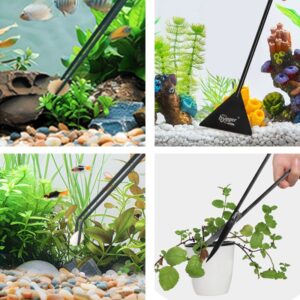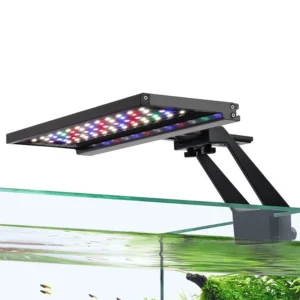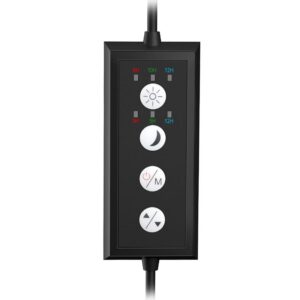Lucky Bamboo Grows in Aquarium Tanks
Lucky bamboo, scientifically named Dracaena sanderiana, is a popular houseplant, belonging to the family Asparagaceae. It is famous for its graceful appearance and association with good fortune. While commonly grown in water-filled vases or pots, Lucky bamboo can also thrive when cultivated in aquarium tanks. In this guide, we will share more about Lucky bamboo, like some care pointers of lucky bamboo in water.
Content Table
- Is lucky bamboo toxic to fish
- Can lucky bamboo plants be watered with saltwater tanks
- How to care for lucky bamboo
- How to propagate lucky bamboo
- In closing
Is lucky bamboo toxic to fish
Get into lucky bamboo
1)Growth features of lucky bamboo
| Stalks | Lucky bamboo has thick and upright stalks, which typically are green. These stalks are segmented, with nodes and internodes along their length. The stalks can grow tall and straight, reaching varying heights depending on the age and growing conditions. |
| Leaves | With a glossy appearance, the leaves of lucky bamboo are lance-shaped and narrow. Also, the leaves emerge from the nodes along the stalks, usually in clusters or tufts. |
| Rhizomes | Rhizomes are thick, horizontally growing stems that produce roots and new shoots. These rhizomes allow the plant to propagate and spread horizontally underground. |
| Growth Pattern | Lucky bamboo grows relatively slowly. However, under optimal conditions, it can gradually grow taller and produce new shoots from the rhizomes. Generally, it grows vertically, with new stalks emerging from the base or nodes of existing stalks. |
| Branching | Occasionally, lucky bamboo can produce side shoots or branches from the main stalks. These branches can contribute to a fuller and bushier appearance of the plant. |
| Adaptability | With great adaptability and the ability to tolerate a wide range of growing conditions, lucky bamboo can thrive in low-light conditions. It can also tolerate varying levels of humidity, but it prefers moderate to high humidity. |
2)Benefits of growing lucky bamboo in aquariums
Aside from its aesthetic appeal, lucky bamboo in aquariums can provide several benefits. It can help regulate water quality by absorbing excess nutrients and serving as a natural filtration system. The lucky bamboo plants also offer shelter and hiding spots for small aquatic organisms, contributing to a more natural and balanced ecosystem within the tank.
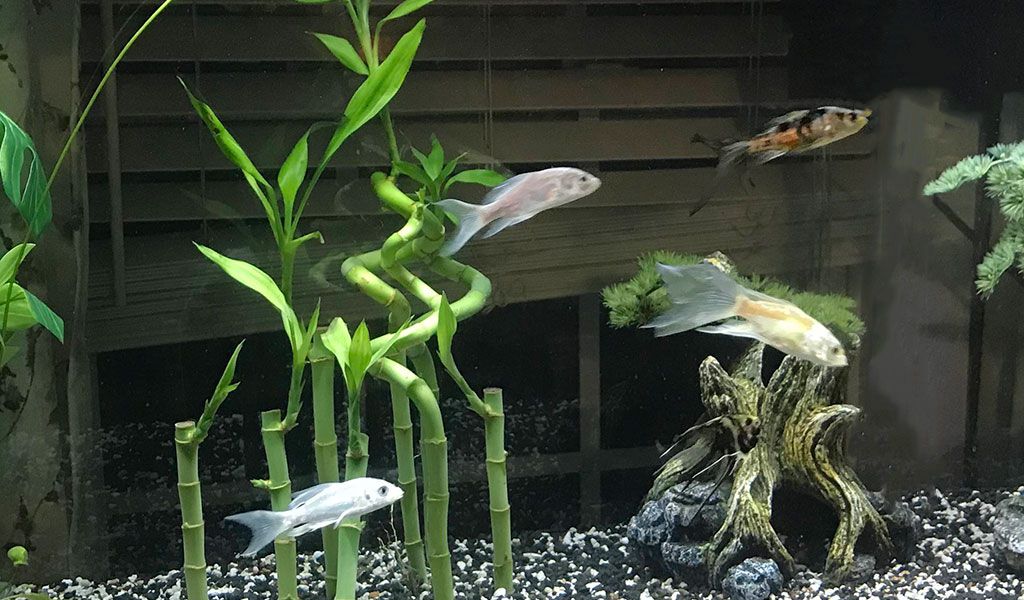
Is lucky bamboo toxic to fish? Yes or No?
Lucky bamboo is generally considered non-toxic to fish. It is listed as a safe plant to keep in aquariums with fish. Lucky bamboo is not known to release any harmful substances or toxins into the water that could adversely affect fish or other aquatic animals.
However, while lucky bamboo itself is not toxic, other factors related to its cultivation in an aquarium can potentially impact fish health. For example, if the water quality deteriorates due to inadequate maintenance or if the plant starts decaying, it can negatively affect the fish.
Overall, lucky bamboo is generally considered safe to keep in aquariums with fish, as long as proper care and maintenance are provided to ensure the overall health of the living environment.
Can lucky bamboo plants be watered with saltwater tanks
Lucky bamboo is not well-suited for watering with saltwater in aquarium tanks. Lucky bamboo is a terrestrial plant that naturally grows in freshwater environments. While it can tolerate some exposure to brackish water, it is not adapted to thrive in full saltwater conditions.
Saltwater contains high levels of salt, which can be detrimental to the health and growth of lucky bamboo. Kept in saltwater, the plant’s leaves will turn brown, curl, or become discolored. The salt content can also disrupt the plant’s water absorption and nutrient uptake, leading to dehydration and poor overall growth.
Lucky bamboo should be watered with fresh and dechlorinated water. Use tap water that has been treated with a de-chlorinator or allow tap water to sit for 24 hours to dissipate chlorine. Water the plant when the substrate feels dry to the touch, but avoid overwatering, as it can lead to root rot.
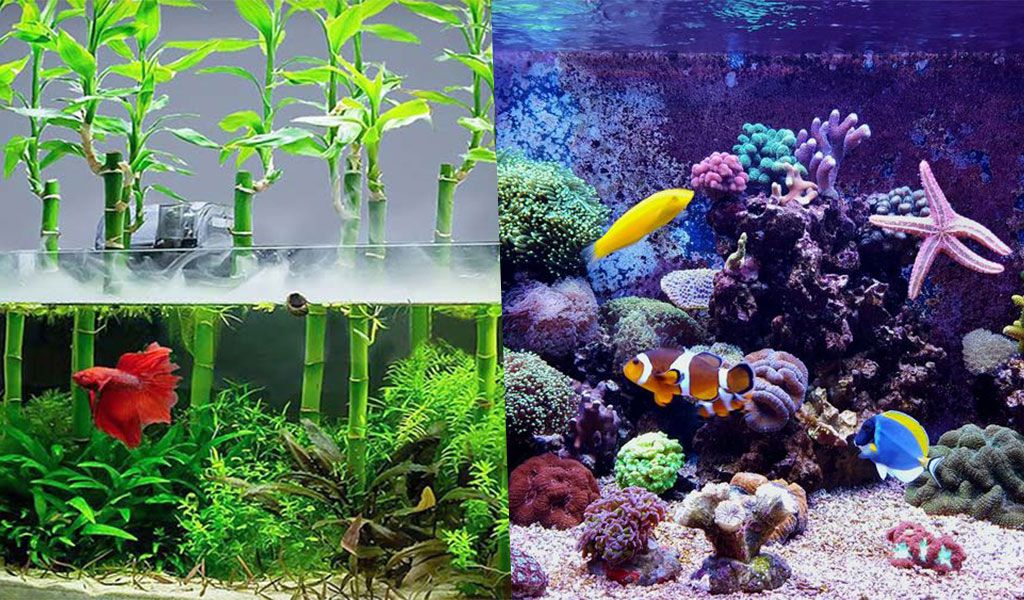
How to care for lucky bamboo
Selection of lucky bamboo species
Choose a suitable species or variety of lucky bamboo that can tolerate submerged conditions. For example, the Ribbon Dracaena (Dracaena braunii) is specifically well-suited for growing in water.
Provide suitable substrate
To plant Lucky Bamboo in an aquarium, it is best to use a substrate or planting medium that promotes root development while allowing water to flow freely. A combination of gravel and aquatic plant soil is an excellent option. The bamboo can be placed in the substrate, ensuring that the roots are well-covered, and the stems remain above the water surface.
Ensure proper lighting
Though lucky bamboo can tolerate low light conditions, moderate to bright indirect light is perfect to support healthier growth and vibrant foliage. You can locate the aquarium in places receiving adequate ambient light, or providing sufficient artificial lighting for plant growth. Avoid placing the plant in direct sunlight, as it can cause excessive heat and potential damage.
Maintain optimal water conditions
Regularly monitor water parameters, such as water temperature, pH level, and water hardness. Also, do regular water changes to keep great water quality and clean water. Plus, creating a great filtration system is necessary.
By the way, if the lucky bamboo shows signs of decay or deterioration, just promptly remove it from the aquarium to prevent any negative impact on the water quality.
Fertilizer selection
Avoid using any chemicals or fertilizers near lucky bamboo, because it could potentially leach into the aquarium water and harm fish. It is recommended to use natural and aquarium-safe fertilizers.
Lucky Bamboo typically does not require frequent fertilization. When you notice signs of nutrient deficiency, you can use a balanced liquid fertilizer specifically formulated for aquatic plants. Also, avoid over-fertilization, which can harm the plant and affect water quality.
Pruning & Maintenance
Regularly check whether lucky bamboo shows signs of decay, yellowing leaves, or algae growth. Remove any decaying or dying leaves promptly to maintain the plant’s health and appearance. Plus, trim the stems as necessary to control the height and maintain a desirable shape.
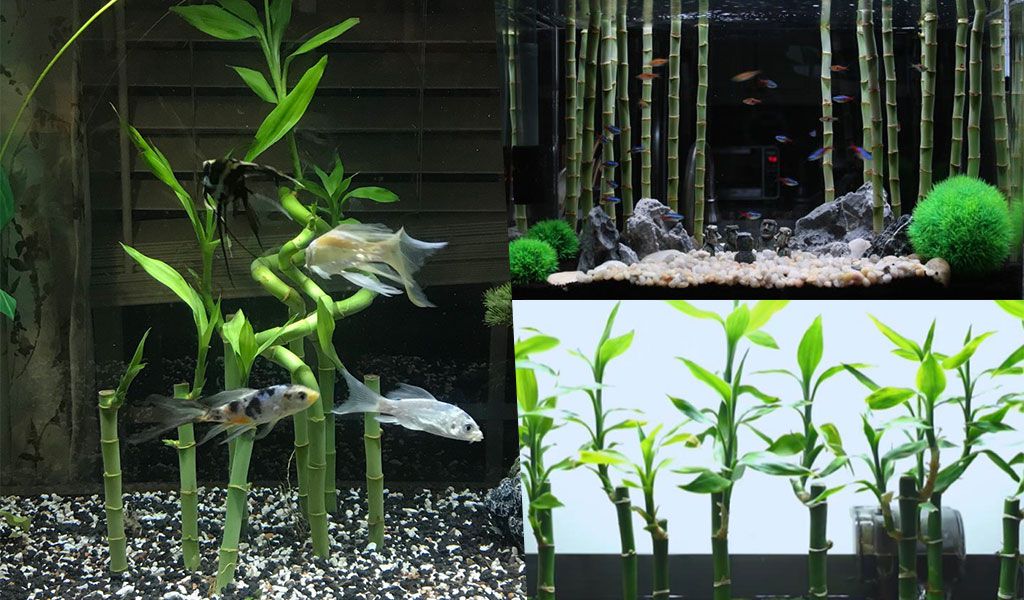
How to propagate lucky bamboo
Propagating lucky bamboo in aquariums can be done through a simple process called stem cuttings. Here is a step-by-step guide on how to propagate lucky bamboo in aquariums.
Step 1: Select healthy stems
It is better to choose healthy and robust stems of lucky bamboo for propagation. Stems that have at least a few nodes (raised sections on the stem) from which new roots can develop are excellent options.
Step 2: Cut the stem and remove the lower leaves
You can cut a stem section below a node with the help of a clean and sharp pair of scissors or pruning shears. The cutting stem section should be at least 4–6 inches long, with at least a couple of nodes on the cutting stem.
Plus, remove the lower leaves from the cutting stem section, leaving a few leaves at the top intact. It helps to redirect energy towards root development.
Step 3: Place the cutting stem section in water
Fill a small container with fresh and dechlorinated water. Submerge the cut end of the cutting stem section into the water, ensuring that at least one node is fully submerged. The leaves should be kept above the water surface.
Step 4: Root development
Over time, new roots will start to emerge from the submerged nodes of the cutting stem. This process can take several weeks or even longer. Monitor the cutting regularly to observe root growth.
Step 5: Transplanting
Once the new roots have developed to a sufficient length (about 1–2 inches), you can carefully transfer the propagated lucky bamboo into the aquarium. Plant it in a suitable substrate, ensuring the roots are well-covered, and the stem remains above the water surface.
In closing
Overall, lucky bamboo is a tropical plant that prefers warm temperatures. While it is primarily a terrestrial plant, when partially submerged in water, it can tolerate a wide range of temperatures between 65℉ (18℃) and 90℉ (32℃). To ensure the optimal growth and health of lucky bamboo in aquariums, it is recommended to keep the water temperature within the range of 70℉ (21℃) to 80℉ (27℃), which is also suitable for most tropical fish species commonly kept in aquariums.


